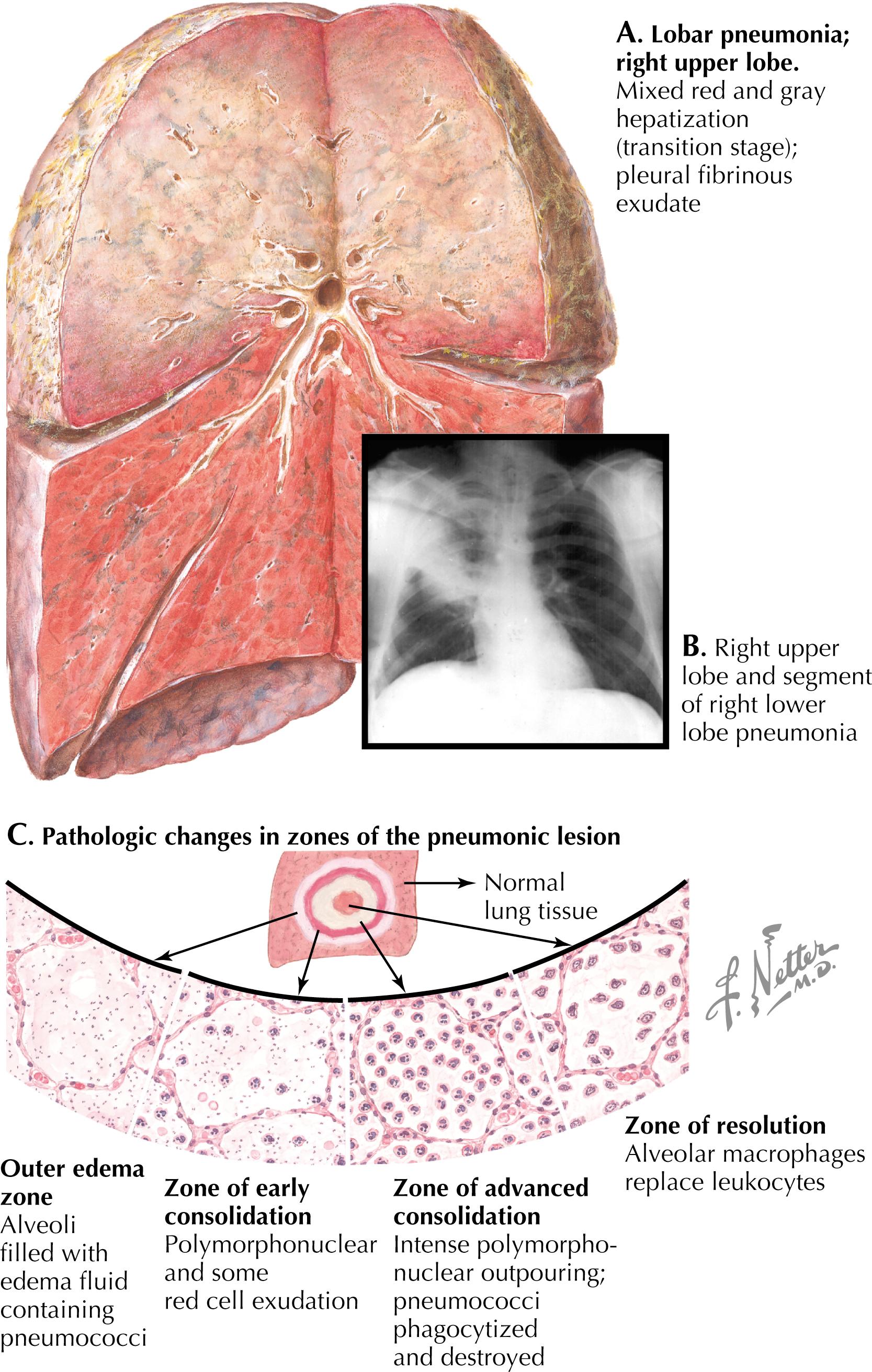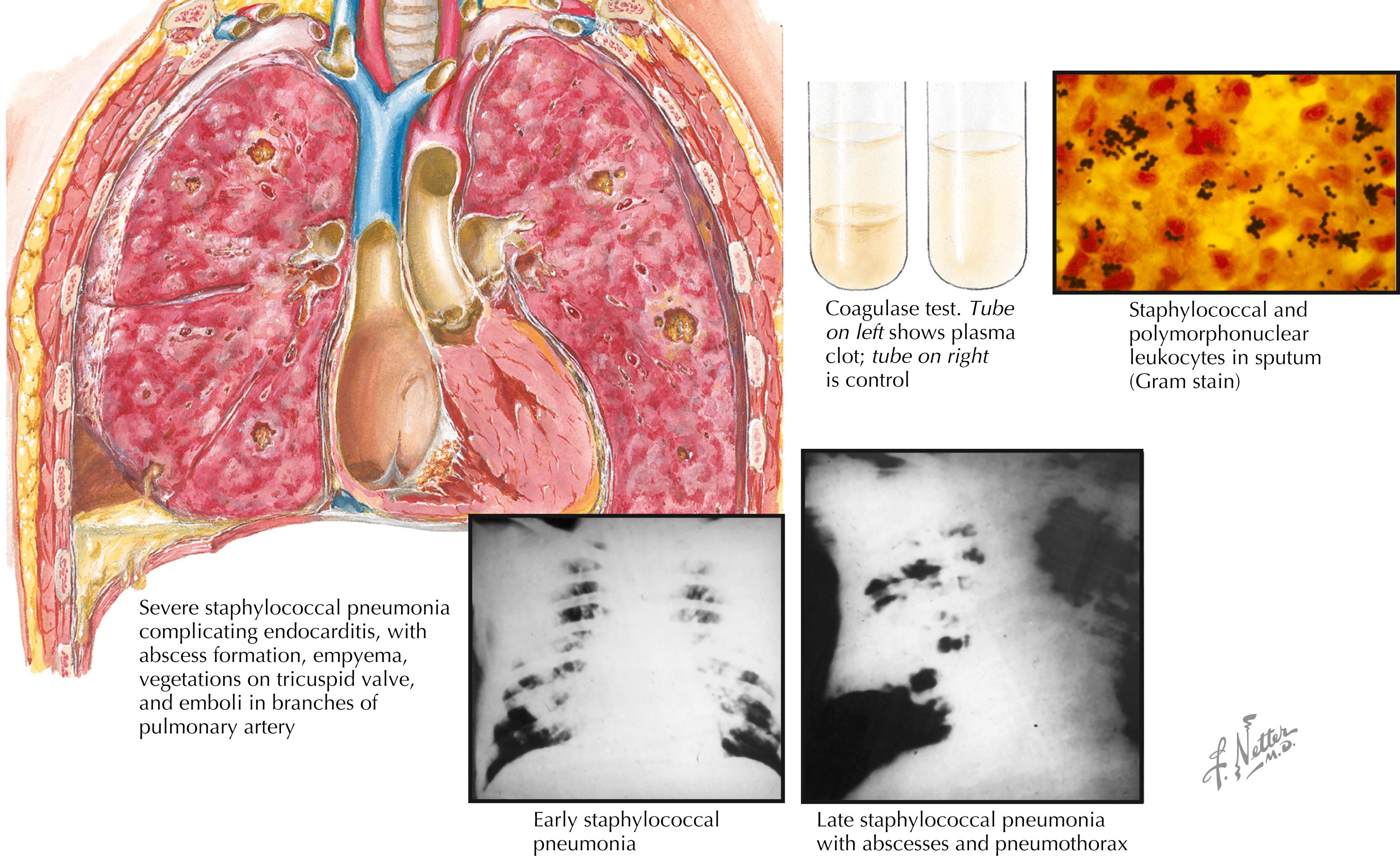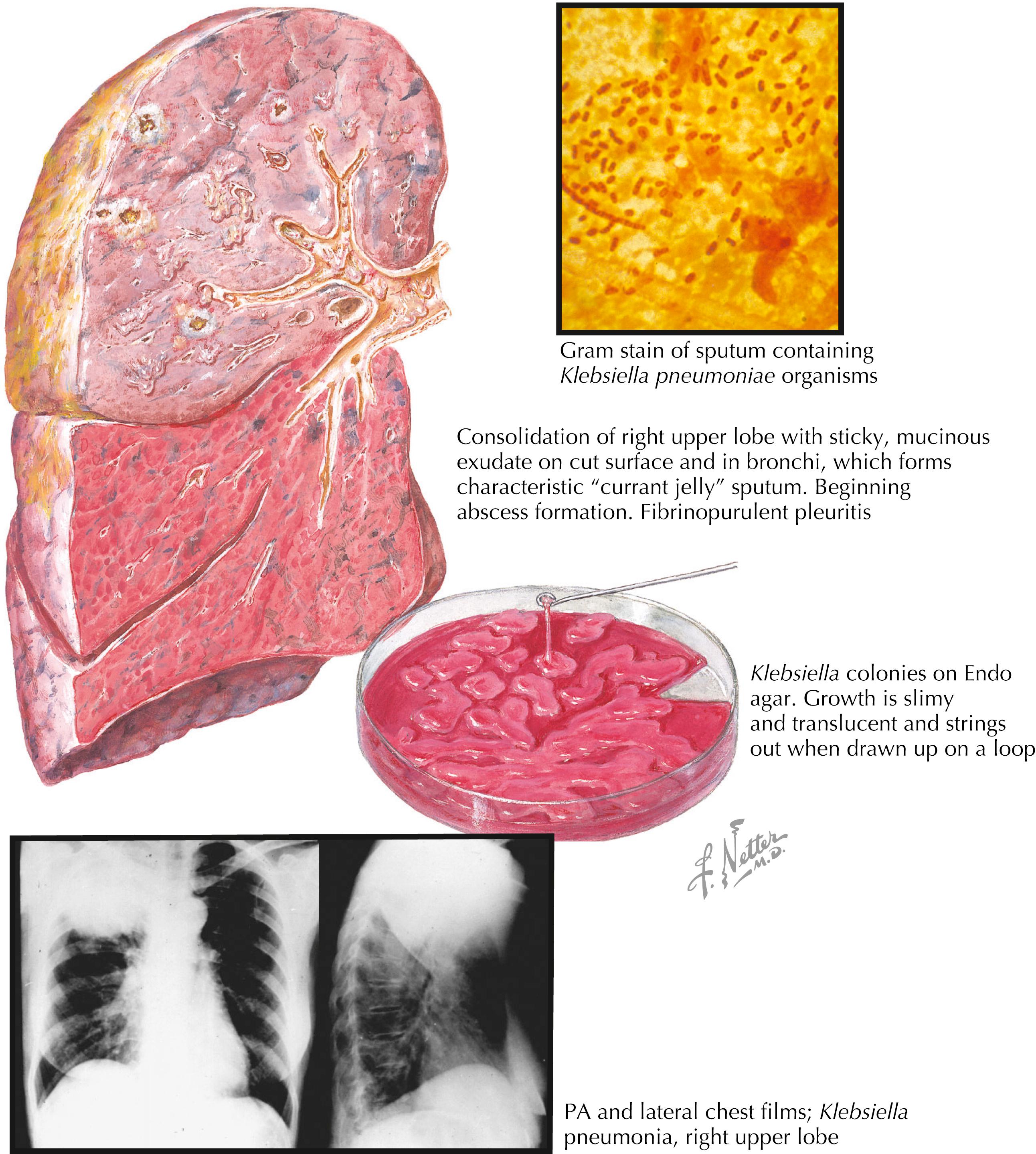Physical Address
304 North Cardinal St.
Dorchester Center, MA 02124
There have been several new developments concerning community-acquired pneumonia (CAP) since the prior version of Netter’s Infectious Diseases ; these include: advances in molecular diagnostic methods to identify the causative pathogen; increasing awareness of viral etiology; decreasing rate of Streptococcus pneumoniae (although still the most common bacterial cause); increase of macrolide-resistant S. pneumoniae ; awareness of the role of the lung microbiome; and elimination of the healthcare-associated pneumonia (HCAP) category for pneumonia.
A 58-year-old male presents in January to an urgent care center with a 2-day history of fever, chills, nonproductive cough, and dyspnea. He has a history of CHF and was immunized previously with both influenza and S. pneumoniae vaccines. Exam: slightly confused per wife; T 38.3°C; blood pressure (BP) 140/80; resp rate 24; pulse 100; pulse oximetry 91%; chest x-ray (CXR) reveals right lower lobe (RLL) reticular, patchy infiltrate. Labs: white blood cell (WBC) 9000; influenza polymerase chain reaction (PCR): negative.
Patient administered ceftriaxone and azithromycin and transferred to hospital.
FOLLOW-UP: Blood cultures obtained prior to antimicrobial administration were no growth and urinary antigen tests for S. pneumoniae and Legionella were not detected. No sputum was produced; a multiplex PCR respiratory panel was positive for human metapneumovirus. Procalcitonin on day 2 was very low at less than 0.1 ng/mL. Based on the positive test for a respiratory virus and negative studies for bacterial coinfection and a low procalcitonin level suggesting bacterial infection was unlikely, the antibacterial agents were discontinued on day 2. The patient was clinically improved at 48 hours and discharged. At 30 days follow-up, he was back to baseline status.
CAP is defined as an acute infection of the pulmonary parenchyma in a patient who has acquired the infection outside of the hospital setting. CAP is a common and potentially serious illness, particularly in elderly patients and those with significant comorbidities. The term HCAP was previously used to identify patients at risk for infection with multidrug-resistant pathogens since they had some exposure to a healthcare setting (e.g., prior hospitalization or patient of a long-term care facility, dialysis, etc.). However, this categorization may have been overly sensitive, leading to increased, inappropriately broad antibiotic use and was thus retired. Patients previously classified as having HCAP should be managed in a similar way to those with CAP (assessing risks for drug resistant organisms) because patients with HCAP frequently present from the community and are initially cared for in emergency departments.
An update of the American Thoracic Society/Infectious Diseases Society of America (ATS/IDSA) guidelines on the management of CAP has recently been published. This chapter will focus on the general approach to CAP in adults, with a concentration primarily on typical bacterial causes. Other chapters focus specifically on pneumonia caused by aspiration, viruses, or atypical organisms.
CAP is associated with significant morbidity and mortality and considerable costs of care. In the United States, CAP is the most frequent cause of death resulting from infectious diseases and is the eighth leading cause of death overall. The mortality rate of patients ranges from less than 1% for patients treated on an outpatient basis to 30% for those with severe CAP who require admission to the intensive care unit (ICU). Data from the Centers for Medicare and Medicaid Services database estimate the 30-day mortality rate of CAP patients (mostly those >65 years of age) requiring admission to the hospital in the United States to be approximately 12%.
The overall rate of CAP ranges from 8 to 23 per 1000 persons per year, depending on the population considered; the highest rates are at the extremes of age. More cases occur during the winter months. In the United States, approximately 30% of patients with CAP are hospitalized. The economic cost exceeds $17 billion a year.
Historically, the lung had been considered sterile. However, newer molecular and gene sequencing methods have identified diverse communities of microbes that reside within the alveoli. This resident flora may play a role in the development of pneumonia, either by modulating the host immune response to infecting pathogens or through direct overgrowth of specific pathogens within the alveolar microbiome.
Respiratory pathogens are primarily transmitted from person to person via droplets or, less commonly, via aerosol inhalation. Following colonization of the nasopharynx microorganisms may reach the lung alveoli via microaspiration. When the inoculum size is sufficient and/or host immune defenses are impaired, infection results. Replication of the pathogen, the production of virulence factors, and the host immune response lead to inflammation and damage of the lung parenchyma, resulting in pneumonia.
Once bacteria reach the lungs, they can cause an inflammatory response that results in disease. This is best studied with S. pneumoniae, which in the absence of opsonizing antibodies, rapidly multiplies in the alveolar spaces, leading to local hyperemia, edema, and mobilization of neutrophils. The filling of alveoli with bacteria, red cells, and fluid leads to significant increase in weight of the lung in this early phase of consolidation ( Fig. 26.1 ). Subsequently this leads to advanced consolidation with increased neutrophils, pulmonary cells, and fibrin.

In some cases, CAP might also arise from uncontrolled replication of microbes that normally reside in the alveoli. Hypothetically, exogenous insults such as a viral infection or smoke exposure might alter the composition of the alveolar microbiome and trigger overgrowth of certain microbes. Because organisms that comprise the alveolar microbiome typically cannot be cultivated using standard cultures, this hypothesis might explain the low rate of pathogen detection among patients with CAP.
There are several predisposing conditions to development of pneumonia ( Box 26.1 ).
Alterations in the level of consciousness, which predispose to both macroaspiration of stomach contents (because of stroke, seizures, drug intoxication, anesthesia, and alcohol abuse) and microaspiration of upper airway secretions during sleep
Smoking
Alcohol consumption
Toxic inhalations
Pulmonary edema
Uremia
Malnutrition
Administration of immunosuppressive agents (solid organ or stem cell transplant recipients or patients receiving chemotherapy)
Mechanical obstruction of a bronchus
Being elderly (there is a marked increase in the rate of pneumonia in persons ≥65 years)
Cystic fibrosis
Bronchiectasis
Chronic obstructive pulmonary disease (COPD)
Previous episode of pneumonia or chronic bronchitis
Uncontrolled comorbidities (e.g., congestive heart failure, diabetes)
Although numerous pathogens have been associated as a cause of CAP, a limited range of key pathogens cause the majority of cases ( Table 26.1 ). The predominant bacterial pathogen continues to be S. pneumoniae (pneumococcus). Although S. pneumoniae (pneumococcus) is the most commonly detected bacterial cause of CAP in most studies, the overall incidence of pneumococcal pneumonia is decreasing in the United States. This likely is in part due to widespread use of pneumococcal vaccination, which results in both a decline in the individual rates of pneumococcal pneumonia and herd immunity in the population. Other causative agents include (but are not limited to) Haemophilus influenzae, Mycoplasma pneumoniae, Chlamydophila pneumoniae, Legionella species, enteric gram-negative bacteria (Enterobacteriaceae), Pseudomonas aeruginosa, Staphylococcus aureus (both methicillin susceptible and resistant), anaerobes (aspiration pneumonia), and respiratory viruses (influenza, adenovirus, respiratory syncytial virus, parainfluenza, coronavirus). Respiratory viruses have been detected in approximately one-third of cases of CAP in adults when using molecular methods. The extent to which respiratory viruses serve as single pathogens, cofactors in the development of bacterial CAP, or triggers for dysregulated host immune response has not been established.
| Ambulatory Patients | Hospitalized (Non-ICU) | Severe (ICU) |
|---|---|---|
| Streptococcus pneumonia Mycoplasma pneumonia Haemophilus influenza Chlamydophila pneumonia Respiratory viruses a |
S. pneumonia M. pneumonia C. pneumonia H. influenza Legionella species Aspiration Respiratory viruses a |
S. pneumonia Staphylococcus aureus Legionella species Gram-negative bacilli H. influenzae |
a Influenza A and B, adenovirus, respiratory syncytial virus, parainfluenza.
S. aureus ( Fig. 26.2 ) and gram-negative bacilli (such as Klebsiella species; Fig. 26.3 ) are less frequently isolated and are the cause in selected patients (e.g., patients with severe CAP requiring intensive care admission or those who have recently received antimicrobial therapy or have pulmonary comorbidities). The frequency of other causes—for example, Mycobacterium tuberculosis, Chlamydia psittaci (psittacosis), Coxiella burnetii (Q fever), Francisella tularensis (tularemia), and endemic fungi (histoplasmosis, coccidioidomycosis, blastomycosis)—varies with epidemiologic setting. The alveolar microbiome is similar to oral flora and primarily comprised of anaerobic bacteria (e.g., Prevotella and Veillonella ) and microaerophilic streptococci.


Antimicrobial resistance, especially the emergence of multidrug-resistant S. pneumoniae , has escalated worldwide over the past two decades. Risk factors for drug-resistant S. pneumoniae include very young age (≤2 years) and old age (≥65 years); β-lactam, macrolide, or fluoroquinolone therapy within the previous 3 months; alcoholism; medical comorbidities; immunosuppressive illness or therapy; and exposure to a child in a daycare center. Available data suggest that a clinically relevant level of penicillin resistance is a minimum inhibitory concentration (MIC) of 4 mcg/mL or greater. At this breakpoint the rate of penicillin resistance for pneumonia for most locations in North America is 10% or less. Since the prior version of Netter’s Infectious Diseases , there continues to be an increase of macrolide-resistant S. pneumoniae . In many regions of the world, including the United States, the overall prevalence of macrolide-resistant S. pneumoniae (high level and low level) is now greater than 25%; in the United States, it is greater than 40%.
The host immune response to microbial replication within the alveoli plays an important role in determining disease severity. For some patients, the local inflammatory response in the lung is sufficient to localize the infection; in others, a systemic immune response may be necessary to control infection and prevent spread or complications, such as bacteremia. In a minority, the systemic response can become dysregulated, leading to tissue injury, sepsis, acute respiratory distress syndrome, and/or multiorgan dysfunction.
Symptoms and signs of CAP include cough (either productive or nonproductive), pleuritic chest pain, shortness of breath, temperature greater than 38°C, and crackles on auscultation. Mucopurulent sputum production is more frequently found in association with bacterial pneumonia, whereas scant or watery sputum production is more suggestive of an atypical pathogen. Although there are classic descriptions of certain types of sputum production and particular pathogens (e.g., pneumococcal pneumonia and rust-colored sputum), these clinical descriptions usually do not help with initial clinical decision-making regarding treatment because the clinical presentations of the specific pathogens are variable. Gastrointestinal symptoms (nausea, vomiting, diarrhea) and mental status changes may accompany respiratory manifestations. Signs and symptoms of pneumonia can also be subtle in patients with advanced age and/or impaired immune systems, and a higher degree of suspicion may be needed to make the diagnosis.
On physical examination the majority of patients are febrile, although this finding is frequently absent in older patients. Increased respiratory rate is frequently noted, and this may be the most sensitive sign in elderly patients; tachycardia is also common. Chest examination reveals audible rales in most patients, and approximately one-third have evidence of consolidation. However, no clear constellation of symptoms and signs has been found to accurately predict whether or not the patient has pneumonia.
The major blood test abnormality is leukocytosis (typically 15,000 to 30,000 per mm 3 ) with a leftward shift. Leukopenia can occur and generally is associated with a poor prognosis.
Adult patients who are immunocompetent should be evaluated for pneumonia if they demonstrate signs including cough, sputum production, labored breathing (including altered breath sounds and rales), and/or fever. These symptoms (especially cough) are nonspecific and may also be present in patients with other diseases that should be considered in the differential diagnosis ( Box 26.2 ; Fig. 26.4 ).
Upper respiratory tract
Acute or chronic sinusitis
Lower respiratory tract
Acute or chronic bronchitis
Acute exacerbation of chronic obstructive pulmonary disease
Bronchiectasis
Tuberculosis
Become a Clinical Tree membership for Full access and enjoy Unlimited articles
If you are a member. Log in here